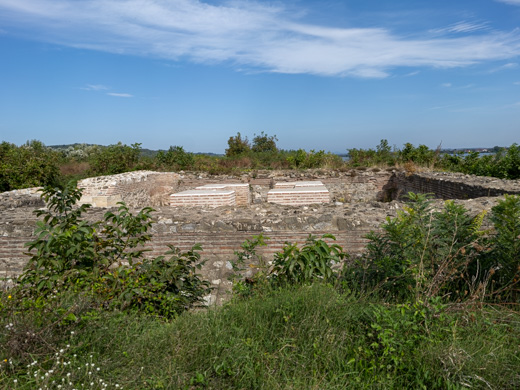Mora Vagei
Competent protection institution: Regional institute for the protection of cultural monuments Niš. The locality is managed by Krajina museum, Negotin
Mora Vagei,Negotin municipality, Bor administrative county
The site is listed on the preliminary list of world cultural heritage (UNESCO) – Borders of the Roman Empire. The enlisting in the Central register of the cultural monuments of the Republic of Serbia is under way, to be enlisted as immoveable cultural good-archaeological site. The location enjoys previous protection.
Where is it located?
Mora Vagei fortification is built on the plateau 2,5 km east of the village Mihajlovac, on the road towards Negotin, on the left bank of Kamenički potok on its estuary to the Danube. The fort is located along the Roman road via publica leading from Egeta (Brza Palanka) towards the Roman town of Aquae (Prahovo) and is the only preserved military fortification on the Danube limes, between Bezdan and the estuary of Timok into the Danube.

History
Military fortification Mora Vagei in Mojkovac near Negotin was a part of the Danube limes, formed for the defense of the Roman Empire from the barbarians coming from the east.
The first travel writer mentioning the remains of the fortification was Felix Kanitz in the late 19th century.
Systemic research of the locality began in 1980-1981 and in the first season revealed the remains of the multi restored fortification. Conservatory works ensued immediately. This locality exhibits the signs of inhabitance from the neolith till late 6th century.
The first fortification was built during the Roman dominance in this area, in the 1st century A.D. In the late 3rd and during the 4th century, a second fortification was built, that was destroyed and twice restored in the 6th century.
A rural necropolis was formed in this area in the 11th century.
Conservatory works begun in 2016 and finished in 2022. The site is now ready for presentation.

Description
Late antique fortification with a square base, 18,50 x 18,50 m, with a tower in the middle. The ramparts are built with hewn stone bound by lime mortar, with final layers made of brick. The main gate in the middle of the western rampart was 1,80 , wide. It was modified twice: the first time the entrance was narrowed and the second time, walled up. The middle tower 6 x 6 m had the foundations of river pebbles bound by quicklime. At the bottom of the tower there was a well from where the fortification was drawing water during the sieges.
The edifices within the fortification had basements and upper floors, in order to maximize the small space of the fortress.
Around the fortifications there were two 3,30 m wide trenches. The first one was 15 m away from the ramparts and the second one at approximately 22 m. .

Dating
The late antique fortification Mora Vagei was built in late 3rd and early 4th century.
The restoration of the fortification, its second phase, was in 5th-6th century.
Јулка Кузмановић Цветковићархеолошкиња
